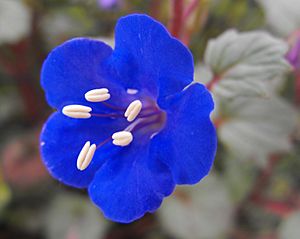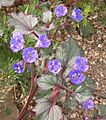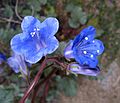Desertbells facts for kids
Quick facts for kids Desertbells |
|
|---|---|
 |
|
| Conservation status | |
| Scientific classification | |
| Genus: |
Phacelia
|
| Species: |
campanularia
|
Phacelia campanularia is a beautiful flowering plant that belongs to the borage family. It's often called desertbells or desert bluebells because of its bright blue flowers. You might also hear it called California-bluebell or desert Canterbury bells.
This plant naturally grows in the deserts of California, especially in the Mojave Desert and Sonoran Desert. People also love to plant it in their gardens as an ornamental plant because it's so pretty. Sometimes, it can even be found growing in other places where it wasn't originally from.
Contents
What Does It Look Like?
This plant grows new each year. It stands up straight and can reach about 0.7 meters (or 2.3 feet) tall. The whole plant is covered in tiny, sticky hairs.
Its leaves are a bit round with bumpy, saw-like edges. The bright blue flowers grow in a loose cluster. Each flower can be up to 4 centimeters (about 1.5 inches) long. They can look like little bells, funnels, or even flat circles. Sometimes, you might see white spots inside the flower's "throat." Long parts stick out from the middle of the flower, reaching up to 4.5 centimeters (about 1.8 inches). After the flower blooms, it forms a fruit that looks like a small capsule, up to 1.5 centimeters long.
Different Kinds of Desertbells
Scientists usually recognize two slightly different types of Phacelia campanularia. These are called subspecies or varieties. They can sometimes mix together in certain areas.
- Phacelia campanularia ssp. campanularia: This type is found only in the Sonoran Desert.
- Phacelia campanularia ssp. vasiformis: This type is more common and grows in a wider area. Its flowers can sometimes be larger.
Plant Chemistry
The bright blue color of the desertbells flowers comes from a special natural color called phacelianin. This same color is also found in the blue flowers of another plant called Evolvulus pilosus.
It's good to know that the plant's sap or hairs might cause a little skin irritation or a rash for some people. If you touch the plant, it's a good idea to wash your hands with soap and water as soon as possible.
Images for kids
See also
 In Spanish: Phacelia campanularia para niños
In Spanish: Phacelia campanularia para niños






